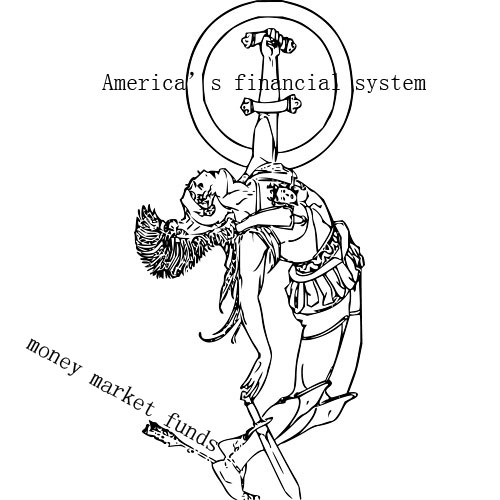 当前美国金融体系最脆弱的环节是什么?这个问题最近没有多少人提及。毕竟,目前看来美国的银行业相当健康,至少比险象环生的欧元区银行强。另外,正在调查中的伦敦银行间同业拆借利率(Libor)丑闻占据了政治辩论和监管机构的主要注意力。
当前美国金融体系最脆弱的环节是什么?这个问题最近没有多少人提及。毕竟,目前看来美国的银行业相当健康,至少比险象环生的欧元区银行强。另外,正在调查中的伦敦银行间同业拆借利率(Libor)丑闻占据了政治辩论和监管机构的主要注意力。
就在市场的注意力为Libor丑闻所牵动时,一场酝酿中的激烈斗争在很大程度上被忽视。这场斗争涉及美国金融体系的一个脆弱环节——规模庞大的货币市场基金。虽然这场斗争可能不会像Libor丑闻那样火药味十足,但投资者仍应密切关注,因其可能对金融世界产生广泛而巨大的影响。
这场斗争的核心问题在于,这个规模达2.6万亿美元的货币市场基金行业,能否承受住“大规模赎回”的冲击。在2008年以前,很少有市场观察人士提出该问题,因为当时货币市场基金给人的印象是“极其呆板”。这也难怪,按道理,货币市场基金只能投资那些“安全资产”(比如高信用等级的债券),投资回报率也低。此外,当时人们普遍认为,货币市场基金绝不会“跌破1美元”(即,投资者绝不会赔本)。
但2008年金融危机打破了这个观念:雷曼兄弟(Lehman Brothers)倒闭时,一家货币市场基金真的跌破了1美元。这引发了市场恐慌。原因在于,尽管享有“呆若死水”的名声,但货币市场基金业有一个阿喀琉斯之踵:与银行账户存款不同,货币市场基金没有任何存款保险为其提供担保,投资者还可随时赎回。这个致命伤导致了“悬崖”问题,正如纽约联邦储备银行(Federal Reserve Bank of New York)近期在一份报告中指出的:如果投资者担心一家货币市场基金可能跌破1美元,他们就有动机尽可能快地赎回。
好消息是,2008年货币市场基金最初遭遇的危机,并没有真正演变为一场毁灭性的大规模赎回。这在很大程度上是因为美国政府介入,为该系统提供了担保。自那以后,美国证交会(SEC)开始引入一些小规模改革,比如:强制性要求各货币市场基金提高短期高流动性资产的持有比例,并进一步加强信息披露,以提振市场信心。
但也有一个坏消息——目前美国政府已被禁止向货币市场基金提供更多担保。美国证交会的小规模改革也无助于化解“悬崖”风险:促使投资者在危机中大规模赎回的动机依然存在。受此影响,货币市场基金经理们成了一群惊弓之鸟。比如,去年夏天,他们就曾以一种非常不利于市场稳定的方式,大量抛售欧元区资产。这种仓皇而逃的景象很容易再次出现。比如,美国某政府部门近期进行了一项秘密研究,评估某些企业借款人违约或欧元区形势进一步恶化可能产生的影响。研究人员发现,在这两种情况下,太多货币市场基金都将跌破1美元。他们认为,该结论会制造过多恐慌,因此不适合公开发表。
那么存在解决办法吗?美国证交会在自己职权范围内正努力推动两大改革设想。其一是,美国证交会希望货币市场基金能够持有现金储备、吸收损失,并允许基金资产净值浮动。其二是,美国证交会希望货币市场基金能教育投资者,不能将投资货币市场基金视同在银行账户里存钱。纽约联邦储备银行上周的论文提出了另一个构想:出现危急时,应对货币市场基金投资者施以“围栏”限制,即,强制性要求投资者在基金中留下一小部分资金,以吸收损失。文中称,只需规定2%至4%的资金不允许赎回,即可防止大规模赎回。
在我看来,上述设想似乎非常合理;如果得到执行且相互配合,或许能降低系统性风险。但美国证交会目前面临来自金融业界的巨大压力,要求它放弃以上设想。特别是,货币市场基金经理们主张,这些改革可能增加基金成本,进而降低基金回报率。他们补充道,这将降低投资者对货币市场基金的购买意愿,特别是在当前的低利率大环境已经压低了基金收益率的情况下。比如,美国财资管理专业人士协会(Association of Financial Professional)近期做的一项调查显示,如果美国证交会的改革计划付诸实施,许多企业的财务人员将把资金从货币市场基金转移至银行。
受此影响,有关货币市场基金业改革的辩论陷入了僵局,该行业的发展也“搁浅”了。在华盛顿,没有人会公开表示希望货币市场基金业缩小规模,即便这有利于提高系统稳定性。毕竟,美国企业和地方政府的大量资金是通过货币市场基金筹集的。不过,也没有人希望政府为货币市场基金提供担保,或希望货币市场基金在面对大规模赎回时继续表现得不堪一击。因此,不太令人意外的是,目前尚不清楚美国证交所将于何时(或能不能)鼓起勇气、开始施行这些合理的改革计划。在改革施行之前,大家最好祈祷,不会发生什么可能再次在货币市场基金经理或其投资者中引发恐慌的事情;否则,我们可能都将为目前这种可耻而危险的政策推搪感到后悔。这关乎一个2.6万亿美元的市场。
What is the weakest link in America’s financial system today? That is not a question many have asked recently. After all, US banks look pretty healthy these days, at least relative to the horrors of eurozone banks. And the unfolding Libor saga has dominated much of the political debate and regulatory attention.
But while the markets are distracted by Libor, an intense fight is bubbling, largely ignored, about one weak link in the system – America’s vast money market funds. And while it may not be producing the same fireworks as Libor, investors should watch this battle, since it could have big implications for the wider financial world.
The issue is whether this $2.6tn money market fund sector is vulnerable to “runs”. Before 2008, few observers ever asked that question, since the funds were considered extremely dull. After all, they are supposed only to invest in “safe” assets (think highly rated bonds) and they pay low returns. Moreover, it was widely assumed that money market funds would never “break the buck” (return less than 100 per cent of investors’ cash).
But 2008 shattered that assumption: when Lehman Brothers collapsed, one fund did break the buck. And that sparked a panic. For despite the dull-as-ditchwater reputation, the sector has an Achilles heel: unlike bank accounts, money market funds are not covered by any deposit insurance, and investors can redeem their money at will. That creates a “cliff” problem, as a recent paper* from the New York Federal Reserve says: if investors fear a fund will break the buck, they have an incentive to run, as fast as they can.
The good news is that the initial crisis of 2008 did not spiral into a truly devastating money market run. That was largely because the US government stepped in to provide a backstop for the system. Since then the Securities Exchange Commission has introduced some small reforms: it has forced money market funds to purchase more short-term liquid assets and to offer better disclosure, in an effort to bolster confidence.
However, the bad news is that the US government is now banned from providing more backstops. And these modest changes have not resolved that “cliff” risk: the same incentives are in place for investors to run in a crisis. As a result, money market fund managers are a very skittish bunch. Last summer, for example, they dumped eurozone assets en masse in a distinctly destabilising way. That stampede could easily be repeated. One US government agency, for example, recently conducted a secretive analysis to assess what would happen if some corporate borrowers defaulted, or the eurozone woes got worse. They found that so many funds would break the buck that the conclusions were considered too alarming to publish.
Is there any solution? The SEC, for its part, is pushing two reform ideas: it wants the funds to hold reserve of cash, to absorb losses, and to operate with floating net asset values, to educate investors that these investments cannot be treated like a bank account. Last week’s New York Fed paper proffered another idea: investors should be “gated” in a crisis, or forced to leave a small proportion in the fund to absorb losses; a mere 2-4 per cent could prevent runs, it says.
To my mind, such ideas look very sensible; if implemented in co-ordination, they could probably reduce the systemic risks. But the SEC is now facing intense pressure from the financial industry to drop these ideas. In particular, fund managers argue that reforms would potentially load new costs on the funds – and thus reduce returns. This, they add, would make investors less willing to put money into these funds, particularly given that yields are already being crushed by the low interest rate environment. A recent survey from the Association of Finance Professionals, for example, suggests that many corporate treasurers will shift money from funds to banks if reforms go ahead.
As a result, the debate – and the sector – is stuck. Nobody in Washington will publicly say that they want the money market funds to shrink, even if this create a more stable system; after all, American companies and local governments raise huge amounts of finance from these funds. But nobody wants the government to backstop these funds; or for them to remain so vulnerable to runs. Little surprise, then, that it remains unclear when – or if – the SEC will summon the courage to implement those sensible reforms. Until then, everyone had better hope nothing happens to create a new panic among money market fund managers or their investors; or we may all come to regret this shameful and dangerous $2.6tn policy fudge.
 当前美国金融体系最脆弱的环节是什么?这个问题最近没有多少人提及。毕竟,目前看来美国的银行业相当健康,至少比险象环生的欧元区银行强。另外,正在调查中的伦敦银行间同业拆借利率(Libor)丑闻占据了政治辩论和监管机构的主要注意力。
当前美国金融体系最脆弱的环节是什么?这个问题最近没有多少人提及。毕竟,目前看来美国的银行业相当健康,至少比险象环生的欧元区银行强。另外,正在调查中的伦敦银行间同业拆借利率(Libor)丑闻占据了政治辩论和监管机构的主要注意力。
